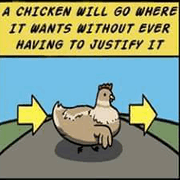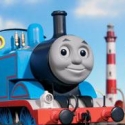|
First class: Same delays, higher price
|
|
|
|

|
| # ? May 11, 2024 11:08 |
|
The point is you don't have to sit next to smelly weird hobos, I guess.
|
|
|
|
I've been hearing rumors that Walt Disney World is going to be phasing out the steam locomotives they use around the park perimeter and replacing them with those diesel powered ones that look like steam locomotives but aren't. Kind of sounds farfetched to me since they just sent off Lily Belle for maintenance like a year ago but that would suck immensely if it is true since those engines have had an amazing history. If Ward Kimball was still alive and found that out he'd be pissed.
|
|
|
|
A potted history of British Rail – how not to run a railway. I've pretty much gone through the major individual classes that failed on British Rail and its successors. One question that is asked again and again is "how did a nation so renowned for its engineering, one that built an empire and stood up to Hitler, manage to gently caress up so badly?" It's a fair question and the answer is very complex - but, I hope, interesting. So I'm going to go through the way I see it in the next series of posts over a week or so. This is where things get a bit political. Maybe contrary to the general zeitgeist of SA, I do fundamentally believe in capitalism, and that free markets do a better job of most things than a centralised state-run economy. I do accept that some things are better off done outside the market. I don’t think capitalism is usually the problem, nor is it accurate to say that the state is the problem. The problem is when the state and big business collude with each other – state corporatism. Where capitalism has poo poo the bed, nine times out of ten it’s because the government has changed its role from regulator of the market to a biased participant in the market, and where politicians are lobbied into making laws that entrench companies from being competitors in a fair market to effectively being clients of the state, combining the state's tendency towards corruption and inefficiency with the private sector's tendency towards monopoly, profiteering and screwing over the little guy. My dad has a saying: “Whenever the government interferes in a market it has no business being in, someone somewhere makes a huge amount of money without doing any work.” I like to think I have some decent evidence to back up my theory, but that’s all it is – my way of looking at the world based on my learning and my experiences. This isn’t D&D and I’m not here to start a fight. But every time I post a story about one of BR’s disasters, people ask how a country that once ruled a third of the planet couldn’t produce a train that didn’t fall apart halfway to its destination, and why things didn’t improve after the railways were privatised. This is why I think that is the case. I will try to evidence everything as best I can. Form your own conclusions; I’m not here to try to convince anyone. Part 1 – when men were men and hats were tall This is the dismal story of British Rail. British Rail, as we have established, was a national joke, and stories of its gently caress-ups have sustained my posting for months. How did it get that way? The British, as we know, were the first to build railways. Railway-building in the early days was very much the preserve of private enterprise. Men with tall hats and impressive moustaches laid rails, built trains and hauled people and goods to where they were needed, providing the lifeblood of the industrial revolution and building impressive Victorian estates with the proceeds. Building track required an Act of Parliament, and thus were the early seeds of corruption sown. The MPs voting on railway-building schemes often had stakes in the companies behind them, or were flat-out bribed. That wouldn’t have been such a problem if the railway schemes were designed with either the good of the country or profitability in mind, but often they weren’t. Many lines were little more than “pump-and-dump” investment scams, or outright economic blackmail, such as this example: This is the route of the first railway built from London Waterloo to Portsmouth by the London and South West railway (LSWR):  As you can see it’s not exactly a quick route, following the LSWR’s main line from London to Southampton as far as Bishopstoke, where it branches off, double-backing on itself to reach Portsmouth from the West. The alternative line, running via Brighton and operated by the London, Brighton and South Coast railway, was if anything even longer and more inconvenient. The reasons for the long diversions were geological – the formidable South Downs hills stretched from Winchester in the West to Hastings in the East with very few ways through. The trains of the time had a tough time with steep gradients and so it was usually best to go around an obstacle than go over it, even, as in this case, if it meant a detour of an hour or more. A group of Portsmouth-based businessmen saw an opportunity to 1 – They had no experience of building or running railways 2 – They clearly had no intention of doing so 3 – There was no way on Earth that a direct line to Portsmouth was practical or economic with the engineering or railway technology of the time. Undaunted, the consortium started building the line, which would feature some ridiculously heavy gradients and no stops at any economically significant places between Godalming (where it joined the LSWR’s existing line) and Havant (where it joined the LBSCR’s line from Brighton). They didn’t care. They guessed, correctly, that the LBSCR and the LSWR would tear each other’s throats out, not so much to own it as to deny it to the other. A vicious bidding war for the unbuilt (stupid) railway broke out between the two companies, finally ending in the LSWR’s favour in 1858. Even then the LBSCR refused the LSWR access to its tracks at Havant and for a year passengers had to travel the last few miles by a rail replacement stagecoach until the LSWR took legal action to force access.  We still have those, and they still stink of horseshit. The “Portsmouth Direct” line was a nightmare to run, but as they’d spent so much money on the drat thing the LSWR ran it anyway at huge losses, having to run short, double-headed trains to cope with the gradients. The speculators counted their cash, twirled their impressive Victorian moustaches, and headed off into the smog. Every local mayor or aristocrat wanted a railway to their little Podunk town or estate. Some of the wealthier aristocratic landowners built their own railways as little more than toys, giving them something to go sightseeing with across their estates and impress women. This chap, the Duke of Buckingham:  "M'lady" Built a whole railway network across his land, ostensibly as a way to deliver goods to his estate, but more in an attempt to get into the corsets of easily-impressed Victorian ladies (remember this is before people used badly modified hatchbacks to do the same thing).  “I'll see your Escort XR3i and raise you a MOTHERFUCKING TRAIN” Some large public schools and hospitals had not only their own railway station, but their own entire networks, carrying people and supplies from one part of the site to another. How on Earth could you afford to run tiny little railways like this? Well the people who operated them weren’t exactly well paid, for a start, and the extent of safety equipment consisted of a glass of whisky and a revolver to end it all quickly if the brakes failed. After a series of horrific accidents the government finally began to intervene and impose safety standards, which, along with passenger demands for greater speed and comfort, drove up costs to the extent that many of the smaller railways were no longer economically viable, and those that were not subsidised by the aristocracy began to disappear. By the outbreak of World War 1, most of the micro-lines had been swallowed up by bigger neighbours or had disappeared. During the war, the running of the railways was taken over by the government, and it was discovered that actually running the railways as a single integrated service had quite a few advantages - and passengers certainly enjoyed the end of practices such as railway companies deliberately loving with the timetables so that their services wouldn't connect with the services of rival companies that they were trying to drive out of business. The great exodus of manpower from the railways, combined with increased wartime traffic levels, played hell with the track and trains and by 1918 the railways were in a dreadful state with a huge maintenance backlog. Some proposed nationalisation, but the investors who had put their entire fortunes into the railways rebelled at the possibility. So, as a compromise, it was agreed (or the government forced everyone, depending on your point of view) that the railways would be combined into four mega-companies: the Southern (SR), the Great Western (GWR), the London and North Eastern (LNER), and the London Midland and Scottish (LMS). Sale of stock in the new companies would finance the badly-needed restructuring costs, and it was clear that many lines were doomed unless substantial economies of scale could be achieved, so it was a deal that investors ultimately accepted. Next, Part 2: The brief period when things actually worked until Hitler hosed it up. Thanks, Hitler.
|
|
|
|
Speaking of micro-lines, how about the London Necropolis Railway?
|
|
|
|
ChickenOfTomorrow posted:Speaking of micro-lines, how about the London Necropolis Railway? I'm pretty sure I saw a bit about that on Great British Railway Journeys. E: Yeah, Series (season) 2, episode 2. Axeman Jim posted:Next, Part 2: The brief period when things actually worked until Hitler hosed it up. Thanks, Hitler. loving Hitler.
|
|
|
|
Axeman Jim if you didn't exist someone (not british) would have to invent you.
|
|
|
|
What is this contraption? It's right behind the drivers cab. I'm in the end car of a SEPTA Hyundai Rotem train. 
|
|
|
|
Axeman Jim posted:A potted history of British Rail – how not to run a railway. As a rebuttal, an old effortpost on the history of British Rail and the clusterfuck we have now by noted trains chat poster and Network Rail signals engineer (I think?) Bozza, archived for posterity here: http://leavesontheline.tumblr.com/post/3487259985/why-privatisation-sucks Bozza posted:Why Privatisation Sucks. e:corrected some spacing (USER WAS PUT ON PROBATION FOR THIS POST)
|
|
|
|
That's the hand brake, it uses a ratchet mechanism attached to a chain to set the brakes when the train is stationary. Fun Fact: in the bad old days prior to the invention of the airbrake, hand brakes were all that trains had. The brakemen would use walkways on the roofs of the cars to walk from car to car, setting the brakes as they went. Since this was done no matter what the weather, and was particularly necessary on mountain railroads where the weather tended to be the worst, it was one of the deadliest jobs of all time. Thankfully the airbrake was invented and the need for roof-top brakemen was eliminated. Disgruntled Bovine fucked around with this message at 23:30 on Apr 8, 2014 |
|
|
|
Well, er, thanks for rebutting a post I haven't even made yet but cheers I guess.
|
|
|
|
Axeman Jim posted:Well, er, thanks for rebutting a post I haven't even made yet but cheers I guess. Well you seem to be conflating railway madness of the victorian era with This Is Why Nationalised Railways Are poo poo so I thought better to get it in sooner than later. e: snide response: it is the free market at work, efficiency Rude Dude With Tude fucked around with this message at 00:09 on Apr 9, 2014 |
|
|
|
Why not get it in if/when I actually say that? (Hint: I won't) Edit: you know, if people are going to attack posts that I haven't even made yet because they've decided that I'm going to express a certain opinion that I don't actually hold, maybe this "tell the story of British Rail in a way that is entertaining" thing is going to be more effort than it's worth. Axeman Jim fucked around with this message at 00:12 on Apr 9, 2014 |
|
|
|
Jim, don't be a nancy and write the drat post. It'll be funny, which is all we can really ask for. Also Mahmoud is literally hitler E: :-]
|
|
|
|
Mahmoud Ahmadinejad posted:Well you seem to be conflating railway madness of the victorian era with This Is Why Nationalised Railways Are poo poo so I thought better to get it in sooner than later. How about you go back to D&D and keep your autism to yourself? I think we all would prefer to read Axeman Jim's effortposts.
|
|
|
|
|
|
|
|
Das Volk posted:How about you go back to D&D and keep your autism to yourself? I think we all would prefer to read Axeman Jim's effortposts. Agreed. I'm here for the horrible trains, not the ridiculous arguments that will change no one's mind. Good trains are cool too, but they don't give me that same strange curiosity as the... sorry... trainwreck ones do.
|
|
|
|
.
sincx fucked around with this message at 05:55 on Mar 23, 2021 |
|
|
|
Thanks all. To be clear: I don't mind people disagreeing with me. I just want to get to the end of my write-up first so that I can present my case as best I can. At least let me state my position and my reasoning for it before you decide that it's wrong. As I said in the post, it's complex and simply boiling it down to nationalised/privatised railways are great/terrible doesn't come close to explaining why Britain's railways have problems that other places don't and why privatising them didn't work. Hopefully I can get part 2 written up tomorrow if work isn't too busy.
|
|
|
|
Axeman Jim posted:A potted history of British Rail – how not to run a railway. I'm sorry but the whole premise of "free markets rule" can be countered by the very existence of modern day Britain. Britain is THE country to watch capitalism gently caress it up for everyone but the people at the top. Or is that capitalism working as normal? I guess it depends on your definition but almost everything privatized in the UK has gotten very much worse right from the start. Nothing got more "competitive", cheaper or faster. The difference, which is obvious to me but apparently not to others, is that free market solutions are working for their shareholders primarily and providing a good service to the customer is only a means to an end. Every shortcut that can raise profits WILL be taken. After all this is expected of any well run company. Maximize profits, please shareholders. A state run service is primarily trying to improve the country in an effort to support growth as a result. It's primary reason to exist is to improve the life of citizens of the state. Why free markets are so aggressive to state run infrastructure I don't understand. It's supporting capitalism by supporting the easy movement of customers and workers. But some people just can't get that and think everything must be a business. And here we are, with a fragmented, dangerous railway that most people can't afford to travel 100 miles on.
|
|
|
|
If you don't mind, I'd like to hear what Axeman Jim has to say. Whatever it is , it will be: 1. Knowledgeable about trains 2. Entertaining regarding trains 3. Have a point of view about trains. Seeing as this is the train thread in AI and not D&D or GBS could we please please stop pre-making GBS threads the thread with nationalization vs. privatization whargarbling?
|
|
|
|
Less politics and capitalism, go to D&D. I wanna see how a country that also makes some brilliant machines, can also royally gently caress them up. Also, the Castle Class locomotives that the GWR used are the best looking steam engines ever made, even over American steam.
|
|
|
|
I don't even know how you could say that, when the A4 class exists.
|
|
|
|
BrokenKnucklez posted:Also, the Castle Class locomotives that the GWR used are the best looking steam engines ever made, even over American steam.  Best looking ever, you say? 
|
|
|
|
No, this thing. It looks magnificent. Simple, clean lines... If there is one things the Brits are remarkable decent at every once in a while, is making mechanical things look great. Now I said every once and a while, not all the time.
|
|
|
|
BrokenKnucklez posted:No, this thing. But that's a hall class, and the pic I posted is Manorbier Castle...
|
|
|
|
Part 2 – the brief period in which everything worked, until Hitler hosed it up. Thanks, Hitler. With the newly formed “Big Four” flush with cash from stock sales and the 1920’s boom, the period from 1923-1939 saw unprecendented investment in the quality, rather than the reach, of the railways. Competition, with the exception of a few routes, was no longer between the railway companies but between the railways and the newly emergent road network. And for long-distance travel, the railways won by a mile. Which would you rather use to get from London to Glasgow – one of these:  Likely cause of death: severely vibrated spine and exposure to lower classes Or one of these:  Likely cause of death: being a character in an Agatha Christie novel For passenger travel the railways beat the roads on speed and luxury and were competitive on price. Whilst they lacked door-to-door convenience the extensive network of branch lines meant that few people were more than a 30 minute walk from a railway station. And that station probably had its own goods yard, with road transport only being competitive in the very final, to-the-door delivery stage of goods. A huge fleet of small tank engines operated “pick-up” freights moving goods from town to town. The Southern invested heavily in electrification, building a cheap, efficient commuter railway for London. Life for the railways was good. Then Hitler bombed it all to poo poo  Made the trains run on time MY ARSE WWII had a devastating impact on the railways. On top of the loss of manpower to the armed services and over-use that had also affected them in WWI, this time around the rail network came under direct attack, with trains, track, factories and maintenance facilities targeted by the Luftwaffe. And this time there was no way for more shares to be issued to repair the damage. The only organisation with any money in Britain was the government, with its Marshall aid from the USA.  The train now arriving at Platform 1, Platform 2, Platform 3, the Cafe and the car park is likely to be delayed The Labour government of 1945 was elected in a landslide victory on a platform of establishing a welfare state and nationalising industry. The railways were the least of what was to end up in state hands – between 1945 and 1951 the government also bought up the coal industry, the electricity generating industry, the telephone system, the canal network, the lion’s share of the road haulage industry. the iron and steel industry, the gas supply industry and even Thomas Cook holidays. The government also owned airlines, car-builders and broadcasters that had a virtual monopoly in their industries due to the state-backed financial clout. Some of these purchases were pragmatic, buying up strategic assets that had been bankrupted by war, and some were ideological – the way that the Soviet Union had beaten Nazi Germany by essentially out-manufacturing it impressed many in Britain and there was a genuine belief that state planning of the economy was the way forward. The railways, nationalised in 1948, probably fell more into the former category. They would be vital for Britain’s economic recovery but there was no private cash available to even so much repair the war damage, let alone improve or modernise them. By the mid-1970s, successive governments of both left and right had managed to run all these industries into the ground, the railways included. I mention this because it’s important to understand that BR was not isolated in being a nationalised industry that fell apart in the mid 20th century, it was part of a generalised industrial decline with multiple causes, some of which stretched back decades. Ironically, the railways in Britain would ultimately end up run on the corporatist model favoured by defeated Nazi Germany – state-directed but privately operated. More of that later. It’s easy to forget that the so-called “Golden Age” of Britain’s railways lasted only 16 years between 1923 and 1939. That’s not long enough for any structural problems to become evident, and the legacy of the over-reach of the network and historic doubling-up of routes between rival companies was something that BR would have to deal with alongside the war damage, antiquated equipment and vastly more effective competition from the roads and air travel. And as we will found out, they dealt with them very, very badly. Time for a brainstorming session. List the personality traits required to succeed as a politician. Chances are that your list looks something like this: -Superficial charm -Ability to know when to brown-nose and when to backstab, often both at the same time -Ability to convince people you can deliver things that you don’t even understand -Ability to talk a lot without saying anything -Ability to tell everyone what they want to hear -Borderline-sociopathic levels of ambition -Ability to change your mind on almost anything without admitting to having done so -Willingness to betray anyone so long as you get ahead -Ability to win elections on 4-5 year cycles Quick question: How many of those traits would you like in your boss? Another quick question: How many of those traits would appear on a list of traits that make an effective manager of a large, complex industrial concern?  "I've managed a nanny AND a butler, I'm sure a multi-billion pound industry is the same general idea." This is the problem that occurs when you put politicians in charge of railways, or any large, complex organisation, and it is what chronically afflicted British Rail throughout its life. As a politician, your life revolves around the election cycle. Anything can happen in an election, so there is no point in planning more than five years ahead. Anything that looks like it will deliver something within 5 years but will actually cause disaster in 10 is a good policy, because you'll be out of office by then and sitting on the board of the organisation concerned. This was the precise opposite of what the railways needed, but that was what they got anyway. From nationalisation in 1948 to privatisation in 1993 and beyond, successive governments made multiple, fundamental changes in what Britain's state-owned railways were supposed to be for and how they were supposed to work. Most of BR's huge failures, and the failures that followed BR, stem from Britain's politicians pathological inability to decide what the railways for for or to leave them alone to actually become that thing before it was time for them to become something else. We'll look at the first massive cock-up in the next post: Next - Part 3: The Modernisation Plan: Not modern, and not much of a plan, either. Axeman Jim fucked around with this message at 19:49 on Apr 9, 2014 |
|
|
|
SybilVimes posted:But that's a hall class, and the pic I posted is Manorbier Castle... Whoops, I just typed in Castle class and thats what popped up. Ok then Hall locos are the best looking.
|
|
|
|
Axeman Joe - I'd come in here ready to tear you a new one about BR (linked from my D&D comrades) but so far your analysis is fairly ok but you are focusing a lot on the overarching vision and management level issues which while important are actually not what BR was about especially if you are comparing to today's railway. BR in a lot of ways was way ahead of everybody else, especially in regards to interlocking and signalling development (even though this doesn't actually become apparent until well after it had died in the 90s). I also disagree with your opinion on a lot of BRs trains, which are starkly utilitarian in many ways but worked. The experimental trains not so much but they were good in their own ways, APT might have had a silly gas turbine engine but its tilting and braking systems were 20 years ahead of their time. BR of the late 80s/early 90s was the best the railway in the UK has ever been run with the least money. I'm sorry if you don't agree, but this is absolutely true, take it from someone in the industry. I won't have it out with you in here cos this is AI not D&D, but come post in the trainchat thread. I won't poo poo your thread up any more!
|
|
|
|
Gas/ban D&D, excited for part 3 Axeman.
|
|
|
|
Cygni posted:Gas/ban D&D, excited for part 3 Axeman. Seconding this.
|
|
|
|
SybilVimes posted:
Yeesh. That's pretty unfortunate looking. I've been reading Axeman Jim's posts in Clarkson's voice, now I can hear all three Top Gear hosts snickering and making jokes about that locomotive.
|
|
|
|
.
sincx fucked around with this message at 05:55 on Mar 23, 2021 |
|
|
|
PhotoKirk posted:Yeesh. That's pretty unfortunate looking. In fairness, Collett only did it because they pretty much said 'everyone else is doing streamlining, so we must' and he felt that the raw power of the Castle & King classes were sufficient (he was right), so basically did the botch jobs on streamlining Manorbier Castle and King Henry VII as a kind of 'piss off and leave me alone' move. In the end, streamlining proved to be a waste of time really, the extra power gained didn't offset the weight of the streamlining, nor the maintenance pain in the rear end, so everyone else (except the LNER) took their streamlining off. Everyone drools over the A4s, but in my opinion, the P2s were the prettier streamlining, in both forms: form1:  Cock O' The North as built with evolved A4/B17 style streamlining. form2:  Cock O' The North in it's revised semi-streamlined form Also as a bonus, there is the pragmatic streamlining of the W1 'hush hush' high pressure locomotive:  And because it's bad to leave the castles looking like Manorbier Castle, here's how they normally looked: 
|
|
|
|
0toShifty posted:What is this contraption? It's right behind the drivers cab. I'm in the end car of a SEPTA Hyundai Rotem train. It's a mechanical handbrake lever.
|
|
|
|
SybilVimes posted:In fairness, Collett only did it because they pretty much said 'everyone else is doing streamlining, so we must' and he felt that the raw power of the Castle & King classes were sufficient (he was right), so basically did the botch jobs on streamlining Manorbier Castle and King Henry VII as a kind of 'piss off and leave me alone' move. I'm sorry but the name of this locomotive has really brought out my inner 12-year-old. That second semi-streamlined version looks really boss though.
|
|
|
|
I realize that keeping politics completely out of this is impossible since so many rail / train projects are done as public works but... for gently caress's sake this isn't D&D. If you want to argue the merits of nationalization versus MAH FREE MARKET then head on over there and start a thread to beat that horse to death. https://www.youtube.com/watch?v=T2x-p9PV7hM
|
|
|
|
Axeman Jim posted:
Is that St. Pancras? That hotel is fuckin' decent these days.
|
|
|
|
Cocoa Crispies posted:Is that St. Pancras? That hotel is fuckin' decent these days. I couldn't stop myself from calling it St. Pancreas. King's Cross manages to be a charming My favorite journey was Reading, which could either take 45 minutes from Fulham Broadway, or 3 hours. Always depended on things like leaves on the track, or mice in the belfry, or whatever ridiculous excuse they came up with at the moment. I always assumed delays were the result of hung over union employees myself.
|
|
|
|

|
| # ? May 11, 2024 11:08 |
|
sincx posted:I am amazed that, in 2014, there are still passenger trains in the UK without automatic doors. The fact that the manual doors are opened and closed by passengers themselves is astounding. No agency in the United States would trust riders enough to shut the doors when they are supposed to be shut. They are quite annoying because once you've lowered the window to reach the handle on the outside, people forget to put the window back up. Which leads to quite a breeze through the carriage.
|
|
|































